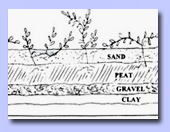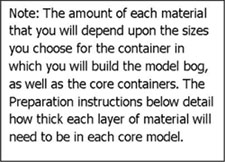 |
 |
 |
|
|
 |
How does the soil in a present day cranberry bog act like a code to tell us about the past? |
|
Lesson Plan: Overview
|
Samples of wet peat, sand, gravel, and wet clay for students to touch and examine (if possible) 4 clear, 6-inch-long plastic tubes, such as containers in which beads or glitter might be sold (available at major chain craft stores). (Click here for alternatives) 1 medium-sized container with straight, opaque sides. Examples: juice carton cut to about six inches in height, a small paint bucket, or a foil pan. Materials for creating model soil layers, as follows or improvised as needed:
Index cards (10; or 10 per group) Masking tape or rope Cranberry Questions chart from Welcome to the Bog 1 ruler per student 1 pencil per student (or a set of colored pencils per student or student group) Exploring Cranberries Web Resources: Decoding the Core Student Worksheet (1 per student)
|
| Credits |

